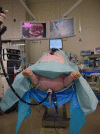Feasibility and Technique for Transvaginal Natural Orifice Transluminal Endoscopic Surgery Liver Resection: A Porcine Model
- PMID: 28030435
- PMCID: PMC5287436
- DOI: 10.1097/SLE.0000000000000367
Feasibility and Technique for Transvaginal Natural Orifice Transluminal Endoscopic Surgery Liver Resection: A Porcine Model
Abstract
Introduction: Natural orifice transluminal endoscopic surgery (NOTES) is a challenging minimally invasive procedure. Although laparoscopic techniques for liver resection are gaining acceptance worldwide, few studies have investigated NOTES liver resection. We used a porcine model to assess the feasibility and safety of transvaginal NOTES liver resection (TV NOTES LR).
Materials and methods: Nine female pigs underwent TV NOTES LR. A nonsurvival acute porcine model with general anesthesia was used in all cases. Using hybrid NOTES technique, we placed only 1 umbilical 12-mm umbilical trocar in the abdominal wall, which was used to create pneumoperitoneum. A laparoscope was then advanced to obtain intra-abdominal visualization. A 15-mm vaginal trocar was inserted under direct laparoscopic vision, and a flexible endoscope was introduced through the vaginal trocar. A long, flexible grasper and endocavity retractor were used to stably retract the liver. The liver edge was partially transected using energy devices inserted through the umbilical trocar. To transect the left lateral lobe, a flexible linear stapler was inserted alongside the vaginal trocar. A specimen extraction bag was deployed and extracted transvaginally. Blood loss, bile leakage, operative time, and specimen size were evaluated. Necropsy studies were performed after the procedures.
Results: Eighteen transvaginal NOTES partial liver resections and 4 transvaginal NOTES left lateral lobectomies were successfully performed on 9 pigs. Mean operative time was 165.8 minutes, and mean estimated blood loss was 76.6 mL. All TV NOTES LRs were performed without complications or deaths. Necropsy showed no bile leakage from remnant liver.
Conclusions: Our porcine model suggests that TV NOTES LR is technically feasible and safe and has the potential for clinical use as a minimally invasive alternative to conventional laparoscopic liver resection.
Conflict of interest statement
B.J.S. received financial support from ValenTx Inc. for work not related to the present research. The remaining authors declare no conflicts of interest.
Figures








Similar articles
-
Comparison of transrectal and transvaginal hybrid natural orifice transluminal endoscopic surgery partial nephrectomy in the porcine model.Urology. 2013 Jul;82(1):84-9. doi: 10.1016/j.urology.2013.03.007. Epub 2013 May 12. Urology. 2013. PMID: 23676357
-
Pure retroperitoneal natural orifice translumenal endoscopic surgery (NOTES) transvaginal nephrectomy using standard laparoscopic instruments: a safety and feasibility study in a porcine model.BMC Urol. 2016 Jun 11;16(1):29. doi: 10.1186/s12894-016-0145-7. BMC Urol. 2016. PMID: 27286863 Free PMC article.
-
Transvaginal Natural Orifice Transluminal Endoscopic Nephrectomy in a Series of 63 Cases: Stepwise Transition From Hybrid to Pure NOTES.Eur Urol. 2015 Aug;68(2):302-10. doi: 10.1016/j.eururo.2015.03.033. Epub 2015 Mar 31. Eur Urol. 2015. PMID: 25837534
-
[Transvaginal hybrid natural orifice transluminal endoscopic surgery cholecystectomy].Ugeskr Laeger. 2016 Jan 25;178(4):V06150482. Ugeskr Laeger. 2016. PMID: 26815719 Review. Danish.
-
Surgery via natural orifices in human beings: yesterday, today, tomorrow.Am J Surg. 2012 Jul;204(1):93-102. doi: 10.1016/j.amjsurg.2011.05.019. Epub 2011 Dec 28. Am J Surg. 2012. PMID: 22206853 Review.
Cited by
-
Postoperative outcomes of natural orifice transluminal endoscopic surgery-assisted vaginal hysterectomy and conventional laparoscopic-assisted vaginal hysterectomy: a comparative study.Obstet Gynecol Sci. 2018 Mar;61(2):261-266. doi: 10.5468/ogs.2018.61.2.261. Epub 2018 Feb 19. Obstet Gynecol Sci. 2018. PMID: 29564318 Free PMC article.
-
Endoscopic trans-esophageal submucosal tunneling surgery: A new therapeutic approach for diseases located around the aorta ventralis.World J Gastroenterol. 2019 Jan 7;25(1):85-94. doi: 10.3748/wjg.v25.i1.85. World J Gastroenterol. 2019. PMID: 30643360 Free PMC article.
-
Gasless transvaginal natural orifice transluminal endoscopic surgery for hysterectomy and salpingectomy on a robot platform with flexible devices in a porcine model.Sci Rep. 2024 Mar 4;14(1):5366. doi: 10.1038/s41598-024-55576-7. Sci Rep. 2024. PMID: 38438509 Free PMC article.
References
-
- Kalloo AN, Singh VK, Jagannath SB, et al. Flexible transgastric peritoneoscopy: A novel approach to diagnostic and therapeutic interventions in the peritoneal cavity. Gastrointest Endosc. 2004;60:114–117. - PubMed
-
- Jagannath SB, Kantesovoy SV, Vaughn CA, et al. Per oral transgastric endoscopic ligation of fallopian tubes with long term survival in poricine model. Gastrointest Endosc. 2005;61:449–453. - PubMed
-
- Wagh MS, Merrifield BF, Thompson CC. Survival studies after transgastricoophorectomy and tubectomy in a porcine model. Gastrointest Endosc. 2006;63:473–478. - PubMed
-
- Kantesovoy SV, Hu B, Jagannath SB, et al. Transgastric endoscopic splenectomy: Is it possible? Surg Endosc. 2006;20:522–525. - PubMed
-
- Bergstrom M, Ikeda K, Swain P, et al. Transgastric anastomosis by using flexible endoscopy in a porcine model (with video). Gastrointest Endosc. 2006;63:307–312. - PubMed
MeSH terms
LinkOut - more resources
Full Text Sources
Other Literature Sources

